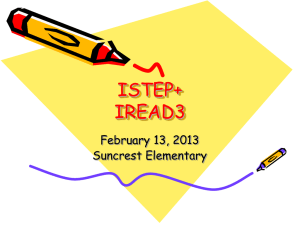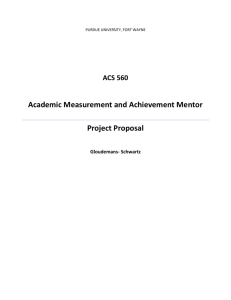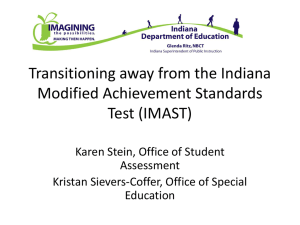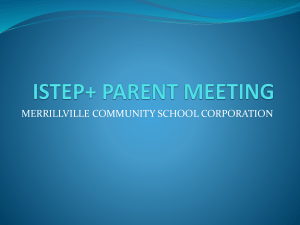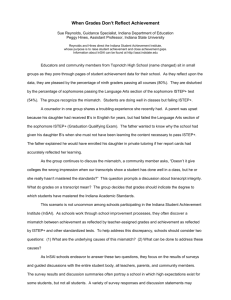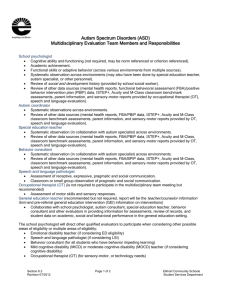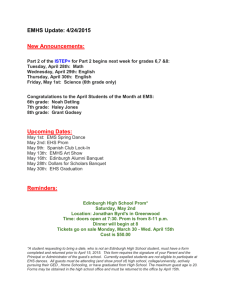Teaching through Mathematical Process
advertisement
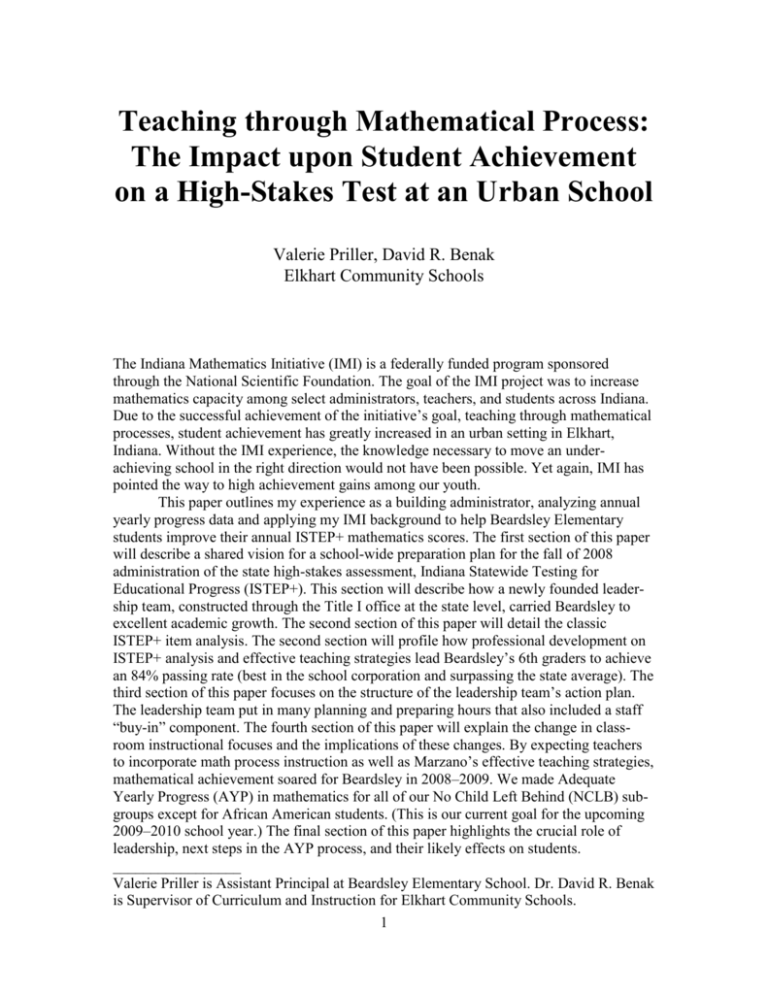
Teaching through Mathematical Process: The Impact upon Student Achievement on a High-Stakes Test at an Urban School Valerie Priller, David R. Benak Elkhart Community Schools The Indiana Mathematics Initiative (IMI) is a federally funded program sponsored through the National Scientific Foundation. The goal of the IMI project was to increase mathematics capacity among select administrators, teachers, and students across Indiana. Due to the successful achievement of the initiative’s goal, teaching through mathematical processes, student achievement has greatly increased in an urban setting in Elkhart, Indiana. Without the IMI experience, the knowledge necessary to move an underachieving school in the right direction would not have been possible. Yet again, IMI has pointed the way to high achievement gains among our youth. This paper outlines my experience as a building administrator, analyzing annual yearly progress data and applying my IMI background to help Beardsley Elementary students improve their annual ISTEP+ mathematics scores. The first section of this paper will describe a shared vision for a school-wide preparation plan for the fall of 2008 administration of the state high-stakes assessment, Indiana Statewide Testing for Educational Progress (ISTEP+). This section will describe how a newly founded leadership team, constructed through the Title I office at the state level, carried Beardsley to excellent academic growth. The second section of this paper will detail the classic ISTEP+ item analysis. The second section will profile how professional development on ISTEP+ analysis and effective teaching strategies lead Beardsley’s 6th graders to achieve an 84% passing rate (best in the school corporation and surpassing the state average). The third section of this paper focuses on the structure of the leadership team’s action plan. The leadership team put in many planning and preparing hours that also included a staff “buy-in” component. The fourth section of this paper will explain the change in classroom instructional focuses and the implications of these changes. By expecting teachers to incorporate math process instruction as well as Marzano’s effective teaching strategies, mathematical achievement soared for Beardsley in 2008–2009. We made Adequate Yearly Progress (AYP) in mathematics for all of our No Child Left Behind (NCLB) subgroups except for African American students. (This is our current goal for the upcoming 2009–2010 school year.) The final section of this paper highlights the crucial role of leadership, next steps in the AYP process, and their likely effects on students. _________________ Valerie Priller is Assistant Principal at Beardsley Elementary School. Dr. David R. Benak is Supervisor of Curriculum and Instruction for Elkhart Community Schools. 1 Beardsley’s AYP vision for ISTEP+ progress in fall 2008 Beardsley’s story begins in Elkhart, Indiana, in a slightly above-average math program. In the spring of 2008, Elkhart’s assistant superintendent approached Beardsley with a proposal for a summer leadership academy, to be sponsored by Indiana Department of Education’s Title I allocations. Pilot schools from five different regions of the state were chosen to receive an intense professional development program. As part of the program a distinguished mentor principal with a proven track record would meet in consultation with our group. Beardsley, reluctantly, signed on for this life-changing experience. Beardsley’s vision for AYP was to pass ISTEP+. The problem in the spring of 2008 was that our vision was unfocused and extremely broad in scope. The 2008 summer academy helped narrow our focus and taught us how to create a plan that was realistic and achievable. Our summer leadership team went through an intense professional growth process during our thirty-three arduous hours of work in July 2008. The first step was to understand the test itself and how the point distribution worked with student responses. This work began in February 2008, prior to the summer leadership academy. Teachers were led through a test data analysis session where they looked at how many points each item was worth and the specific responses from Beardsley students. The Beardsley staff then compared the Beardsley student responses to the scoring guides provided by the state. This staff development session was extremely powerful because through the discovery, analysis, and reflective process, teachers and staff members quickly discovered that our students performed poorly on the open response and application portion of the ISTEP+ test. This new discovery led to a sense of urgency for the fall 2008 ISTEP+ test. Teachers knew in the spring where their instructional gaps were and basically how to address these gaps. Although the knowledge of what needed to be done was there, the practical question of when were we going to collaborate and plan had to be tabled until the 2008 summer leadership academy. ISTEP+ Analysis: What does it mean and where can we make significant growth? By the end of the summer leadership academy, a strong, focused, informed Beardsley leadership team had been born. When Beardsley’s team walked into the summer conference, we had no idea what transformation was about to take place. The conference began with team building and the sharing of relevant information. What got our sparks flying was the AYP results and how to interpret them. This was an epiphany for Beardsley’s team because, finally, we understood what everything meant and exactly how achievable AYP was for a struggling school. After the group presentation in July, our team went to a small group room with our distinguished mentor principal, Julie Bakehorn. She walked us through figuring our data results and how many students each AYP cell needed to pass the national expectations. The Beardsley leadership grasped that we only missed AYP by a few students’ sub-par results. Another breakthrough at this session was that many of the AYP cells overlapped. For example, one child could be Hispanic, free and reduced lunch, and special education. This information put faces to the numbers. The team began looking at specific children and their results on the fall 2007 ISTEP+ test. This new leap forward provided a new charge for Beardsley’s AYP progress. Armed with new information, our team identified a “target” list of students and some 2 excellent teaching strategies aimed at achieving great gains on the fall 2008 ISTEP+ test. The target students were Beardsley students who scored 20 points above and below the pass score on the 2007 ISTEP+ test. The remainder of our July 2008 session was spent planning and developing an ISTEP+ prep curriculum complete with a specific pedagogy. Teachers were thrilled to have such an organized calendar of events, which included all necessary materials for teaching the new Beardsley ISTEP+ prep program. The rationale for the team’s decision was that quick results were necessary since we were a comprehensive reform school in terms of the state’s new accountability model. The Structure of the Plan The new plan began with an inspiring introduction of the ISTEP+ prep plan, presented not by the school administrators but by the leadership team. The first staff meeting on the first day back for teachers began with a motivating presentation which walked the staff through the data analysis process the leadership team experienced at the Title I summer leadership academy held in July 2008. Teachers presenting the information helped the staff understand the numbers and the mission of the ISTEP+ prep program. Professional development on how to teach the applied and open-ended questions was also presented to the staff at this time. The structure of the plan provided one hour of ISTEP+ prep a day for all children in grades 3–6 at Beardsley elementary. The focus of instruction was on using some of Robert Marzano’s teaching strategies to tackle released ISTEP+ problems taken from the Indiana Department of Education web site. Specific strategies teachers were expected to use were cooperative learning, questioning and cueing, setting an objective, and writing explanations about how problems were solved. Students were also asked to discuss their strategies as well as their written responses with either the whole group or in small groups. This use of discussion proved a powerful tool in the ISTEP+ prep program. Students had a variety of solutions and strategies to some of the most complex problems on previous ISTEP+ tests. Another part of the structure was to provide small ISTEP+ intervention time for the “target” NCLB students. This intervention time amounted to an additional thirty minutes per day to work on more problems with the same math problem-solving strategies as well as Marzano’s effective teaching strategies. During their intervention time, the target students had more exposure to applied and open-ended questions The target students were strategically placed with the most qualified staff members to insure fidelity to the ISTEP+ prep program. Other students were also given an intervention based on their group’s needs. The ISTEP+ prep program began on the first day of school with a formative assessment which helped identify needs especially within the “target” group. Day 2 of the ISTEP+ prep program began assessing applied skills with a focus on problem-solving methods, followed by discussion among peers. With adult direction, students had to explain why they solved problems in the manner they did. Many of the target students discovered that their peers had effective strategies to solve applied problems. Individual meetings with the target students, another component to the ISTEP+ prep plan, gave them encouragement. It was compelling to watch children as they found out how close they had come to passing the previous ISTEP+ test. Administrators met with each of these children accentuating their strengths and offering suggestions on areas that needed improvement. Children left the office with a new-found confidence and belief that they could pass the ISTEP+ test. 3 Building administrators also completed daily walkthroughs during the ISTEP+ prep program that entailed completing a daily feedback form for each participating teacher. Teachers could also add their own input on the form. This helped teachers get immediate assistance from a member of the leadership team. This peer coaching component also contributed to the success of the program. Administrators left the assistance element to the leadership team, which required a substantial amount of reciprocal trust. An evaluation done by the assistant principal and the principal, Jenny Sader, helped classroom teachers to improve the program for future ISTEP+ prep programs. Teachers bought into the program and the implementation was extremely successful. Classroom Instructional Changes After the ISTEP+ test was completed, the leadership team provided a new focus. Writing across the curriculum is one of Beardsley’s school improvement goals, and that was implemented in the 2008–2009 school year. Problem and strategy discussions were also implemented with specific math curriculum problems. Marzano’s effective teaching strategies continue to be implemented and developed as the main instructional tool expectation. Professional development on these strategies is ongoing and constant. An example of this ongoing professional development came during the November 2008 early release day. The leadership team and the curriculum and development committee on writing provided professional development to help explain applied and open-ended math problems. Modeling and practice were provided for the Beardsley staff. The staff was expected to use writing with math once a week, and documentation was turned into the assistant principal for review. Rich professional conversations resulted on the topic of the writing documentation. Dialogue and professional discourse took place after walkthroughs and the evaluation process. Without the IMI professional background as well as the Everyday Mathematics curriculum experience, these professional conversations would not have been as effective. Classroom observations were also conducted especially during math intervention time when student discourse about the problem-solving process took place. The assistant principal encouraged teachers to let students teach each other through the math problemsolving process. Again, without the professional background knowledge acquired through IMI experience, these professional exchanges would not have been as valuable. Curriculum and professional knowledge is crucial to the success of school improvement initiatives. Our fall 2008 ISTEP+ results reflect a focused, informed, professional effort that makes the difference in the achievement levels of students. The confidence in the children has grown tremendously, and we anxiously await the results of the spring 2009 ISTEP+ tests. Data Analysis To ascertain the efficacy of the instructional approach employed at Beardsley Elementary School, the administrative staff utilized the mathematics battery of the Indiana Statewide Testing for Educational Progress (ISTEP+) to measure student performance. As previously noted, the ISTEP+ is the high-stakes accountability assessment for the State of Indiana, which was administered during the last two weeks of September each year through the fall of 2008. It is important to note that the State of 4 Indiana has changed to a spring testing format that began in March and April of 2009. The rationale behind choosing the ISTEP+ mathematics assessment included: 1) Since ISTEP+ is the state accountability instrument for measuring student progress towards mastery of the mathematics academic standards, student performance on the assessment would be a valid indicator of whether the intervention addressed the appropriate instructional targets; 2) the Indiana Department of Education maintains an extensive data management system for ISTEP+ results, which provides relevant longitudinal, demographic, performance, and disaggregated information for the state, school districts, and schools, and 3) since all public schools in Indiana administer the ISTEP+ assessment, appropriate comparisons can be analyzed. Figure 1 The mathematics battery for the ISTEP+ assessment incorporates both multiple choice and open-response items. On average, approximately one-third (1/3) of the raw score points are open-response type questions. Actually, depending upon grade level and year, between twenty-five (25) percent and thirty-eight (38) percent of the raw score points are generated from open-response items. The point distribution by grade level for the fall 2007 and fall 2008 ISTEP+ assessment is organized in the chart of Figure 1. The blue bars represent the total points at each grade level, while the red bars and the green bars represent the number of points at each grade level for multiple choice and openresponse items, respectively. The point totals and point distribution at each grade level remained relatively static for the 2007 and the 2008 ISTEP+ tests. 5 Figure 2 The open-response items incorporate the state process standards (Problem Solving, Reasoning and Proof, Connections, Communication, and Representation) in both the question prompt and the student response. However, with the exception of problem solving, student performance on these items is attributed to one of the content standards (Number Sense, Computation, Algebra and Functions, Geometry, Measurement, and Data Analysis). As such, the process standards are the hidden standards. Student performance on the open-response items is dependent upon student mastery of the process standards, but state reporting of student performance never reflects these standards. As such, teachers focus upon mathematics content and superficially address, if at all, mathematics process. Typically, there is a huge discrepancy between the percent of points earned through multiple choice items and the percentage of points earned through open-response items (Figure 2). Although, on balance, open-response items generally have a greater cognitive demand than the multiple choice items on the ISTEP+ test, the assumption was made that improving student mathematical processes would yield gains in both multiple choice items and open-response items as well as close the discrepancy between the two types of items. The graph in Figure 2 shows the percentage of points earned overall and according to problem type by grade level and year. The percentage of total, multiple choice, and open-response points earned increased greatly from the 2007 assessment to the 2008 assessment for all grade levels (Figure 2). Furthermore, the difference between the percentage of points earned on multiple choice items and open-response items decreased at grades 4 through 6 (Figure 2). The bar graph in Figure 3 compares state passing rates with Beardsley Elementary School passing rates of all students for the 2007 and 2008 ISTEP+ administrations. The state passing rate for 2008 ISTEP+ was either the same or a little lower for each grade level than the 2007 ISTEP+ (Figure 3). However, Beardsley Elementary School had 6 substantial gains in the 2008 passing rates as compared to the 2007 passing rates at all grade levels (Figure 3). The increases in passing rates for 2008 were a seven (7) percent gain at grade 3, a twelve (12) percent gain at grade 4, a fourteen (14) percent gain at grade 5, and a twenty-seven (27) percent gain at grade 6 (Figure 3). Additionally, the passing rate for sixth grade students at Beardsley Elementary School exceeded the state passing rate in 2008 by four (4) percentage points. It is noteworthy since the cohort group was eighteen (18) percentage points behind the state at grade 5 (Figure 3). Figure 3 Another series of data provided by the Indiana Department of Education utilizes a metric known as the Indiana Performance Index (IPI). According to the Indiana Department of Education, IPI is an estimate of the number of items that a student would answer correctly from one hundred (100) items of similar difficulty. For each grade level, each of the measured standards (Number Sense, Computation, Algebra and Functions, Geometry, Measurement, Data Analysis, and Problem Solving) has an IPI at Standard value assigned as a passing score. Furthermore, each student will receive an IPI score for each of the measured standards. If the student’s IPI score is greater than or equal to the IPI at standard score, then the student has “passed” that particular standard. The state also calculates the mean IPI score for the state, school districts, and individual schools by standard for each grade level. The state data management system has multiple reporting systems that utilize the mean IPI. An extremely useful comparison is the difference between the mean IPI of a school or school district and the IPI at standard for each of the measured grade level academic standards. The intent of the report is to provide a benchmark for schools to analyze student performance within each of the academic standards. If the difference is a positive score, then the mean IPI was greater than the IPI at standard; whereas if the difference is negative, then the mean IPI is less than the IPI at standard. 7 Figure 4 The graph in Figure 4 compares the 2007 and 2008 differences between the mean IPI of Beardsley Elementary School and the IPI at standard for each measured standard by grade level. With the exception of the Data Analysis and Probability standard at grade 5, there were substantial gains for each standard at each grade level from the 2007 to the 2008 administration of ISTEP+ (Figure 4). On average, Beardsley Elementary School students’ mean IPI score increased by 6.9 percentage points relative to the IPI at standard score for each standard at each grade level from the 2007 administration to the 2008 administration of the mathematics battery of the ISTEP+ assessment. Findings The findings from the study include both observational elements from the building-level administration of Beardsley Elementary School and student performance data from the Indiana Department of Education. The major assumption behind the school-wide ISTEP+ preparation plan was that new strategies in the teacher’s classroom planning and behaviors would improve student learning, as measured by the state mathematics assessment. With respect to changes in teacher behaviors observed by the administrative staff of Beardsley Elementary School: 1. Teachers problem-solving focus changed from a solution-oriented approach to a student process-oriented approach. Early in the implementation of the intervention, teachers were trying to solve several problems during the thirtyminute session. When the students could not solve the multitude of problems that were scheduled during the sessions, teachers quickly realized that the students did not have a cognitive framework to solve the problems. As such, teachers began to 8 focus on explicit instruction and the practice of problem-solving approaches, strategies, and techniques. 2. Once teachers emphasized explicit instruction of problem-solving, they began to incorporate the other process standards (Reasoning and Proof, Connections, Communication, and Representation) into the instructional plan and implementation. More specifically, classroom structures were employed that facilitated student discourse to include pair and share, cooperative learning groups, compare and contrast, and student presentation of work, along with the defense of their solutions. The rich student discourse provided students with multiple approaches to solving a problem, multiple representations of mathematical concepts, and fostering higher order questioning. The complexity of student reasoning evolved from explaining how they solved a problem to articulating why they approached the problem a specific way and why they knew the solution was correct. Finally, teachers utilized the student discourse and reasoning to provide explicit instruction on writing in mathematics. Essentially, the sequence was “think it,” “say it,” and “write it.” 3. The final change included teacher discussion during the weekly data team process. Towards the beginning, teacher discussion focused upon student knowledge of mathematical content. The discussion shifted towards the development of student mathematical process skills. Much of the discussion centered upon classroom instruction of assessment, scoring, evaluation, and student feedback on mathematical process. The general findings from the student performance data included: 1. With the implementation of a reform-oriented mathematics at Elkhart Community Schools, a general trend has been established the last several years both districtwide and for each of the schools including Beardsley School, the percentage of students passing the Mathematics ISTEP+ increased at a rate greater than the state from grade 3 through grade 6. For Beardsley Elementary School, data for the 2007 and 2008 administrations of the ISTEP+ mathematics assessment corroborate this trend (Figure 3). Note that in 2007, the state passing rates by grade level were 71% at grade 3, 76% at grade 4 , 78% at grade 5, and 81% at grade 6; whereas, the passing rates for Beardsley Elementary School were 35% at grade 3, 43% at grade 4 , 60% at grade 5, and 57% at grade 6. However, with the implementation of an intervention program that focused upon problem-solving and other process standards, the increase in passing rate substantially increased by grade level. Although the state increase in passing rates by grade level for 2008 were similar to 2007 (Figure 3), Beardsley Elementary Schools grade-level passing rates for 2008 were 42% at grade 3, 55% at grade 4 , 74% at grade 5, and 84% at grade 6. Thus, the gap between student performance at Beardsley Elementary School and the state closed at an accelerated rate. 2. The second general trend was that grade-level student performance on the 2008 ISTEP+ assessment was significantly higher than grade-level student performance on the 2007 ISTEP+ across multiple measures to include: percentage of points earned by students overall on multiple-choice type items and open-response type items (Figure 2), the percentage of students passing the ISTEP+ assessment (Figure 3), and student performance on the measured standards (Figure 4). This trend provides strong evidence that Beardsley Elementary students responded favorably to an instructional approach centered upon problem-solving. 9 Conclusions and Next Steps This paper had two purposes. The first purpose was to chronicle our efforts at Beardsley Elementary School to implement a school-wide program that focused upon teaching through mathematical process. This should provide useful information to educators who wish to replicate the program in other schools. To provide educators with evidence of program efficacy, we have made available herein relevant student achievement data, the second purpose of this paper. The Indiana Mathematics Initiative provided the administrative leadership team with knowledge, experience, and the leadership necessary to assist one urban school reach successful AYP mathematical levels. By developing an academic achievement vision, utilizing an item analysis and strategy selection, designing the structure of the improvement plan, and providing a classroom instructional focus, the administrative leadership team at Beardsley Elementary School significantly improved upon a sound mathematic program. Although teachers received extensive training in the reform mathematics, which incorporates the process standards, a review of the data indicated a weakness in problem-solving. Subsequently, the leadership team provided both a schoolwide goal and the necessary support to improve the teaching of problem-solving and other process standards. After this school-wide goal to re-focus on problem solving was instituted, student achievement soared. The lesson to be learned is that teacher professional development is a continuous process. By careful examination of student data, a building leadership team can identify both an instructional focus and teacher professional development needs. Acting upon both elements in a strategic and well-crafted plan will lead to success. On a personal note, the process has left me profoundly revolutionized and eager to move on to Beardsley’s next steps toward increased student achievement. I am convinced that further professional development in the area of effective teaching strategies, with a focus on how students learn, will undoubtedly contribute to continued student achievement at Beardsley Elementary. 10
